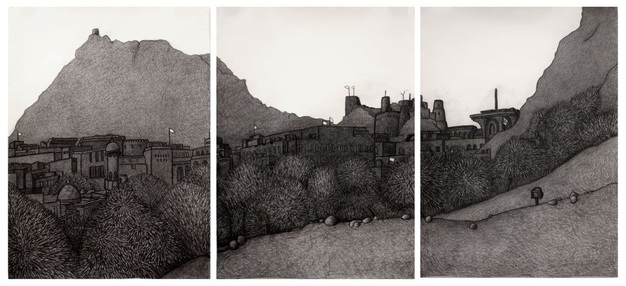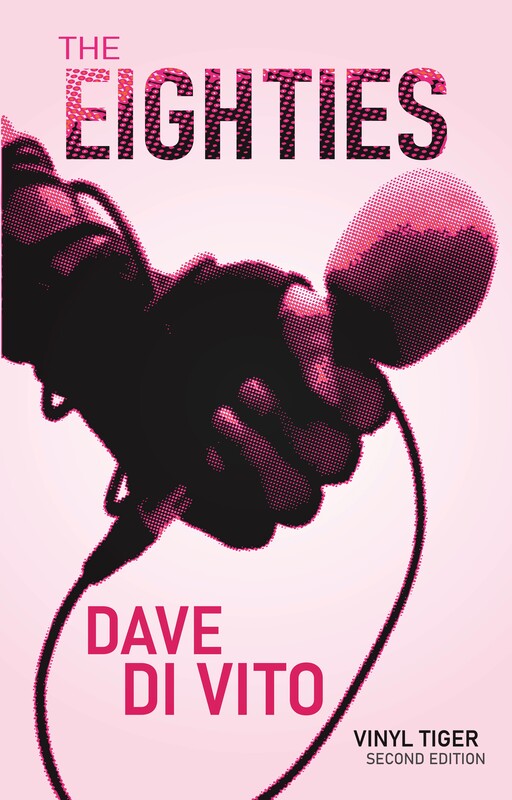|
I have always had a soft spot for print makers. I was never much cop in the print studio myself, but I've always considered print makers to be the real artisans of the visual arts. They're often daring and meticulous in equal measure, and in most cases, the best print makers have trained, trained and trained in order to make work that can appear so effortless. Damon Kowarsky studied printmaking at VCA (Melbourne) and at the Glasgow School of Art and Advanced Figure Drawing with Godwin Bradbeer at RMIT in Melbourne. Since graduating, Damon has gone on to receive numerous prizes and awards including a Toyota Community Spirit Artist Travel Award, APW Collie Print Trust Scholarship, Arts Victoria New Works Grant and Australia Council Asia-Australia Creative Partnerships Grant. He has worked as a scientific, courtroom, and archaeological illustrator, and has travelled extensively in South Asia, Europe and the Middle East, where the architecture and colours of earth and sky inspire much of his work. Damon exhibits regularly in Australia and abroad, and I had the good fortune of convincing him to participate in a show I curated at my old artspace Immersion Therapy in Northcote, Melbourne back in 2008. Since then, I’ve watched with admiration as Damon continues to work, teach, travel, and, yes, exhibit his work. He’s a one man printmaking powerhouse who was kind enough to make some time to answer some of my questions in the lead up to HYBRID II -Project by Damon Kowarsky & Atif Khan at the Islamic Museum of Australia (Melbourne), opening on May 8. …  palace- Damon Kowarsky palace- Damon Kowarsky Hi DK, tell me, what one thing has been taking up the majority of your time so far in 2015? Travel. I was away for the first three months of the year concluding a six month journey through Pakistan, India, Oman, Sri Lanka, Thailand and Malaysia. During that time I also carried out a one month residency at the Bait al Zubair Museum in Muscat, where I produced a 3 metre drawing of the area around the Sultan's palace. What’s been the highpoint of your year to date? Teaching a one day printmaking workshop at the University of Visual and Performing Arts in Colombo was pretty good. The students were great but lacked firsthand experience working with copper plate etching. It was amazing to see them expand their horizons even in the small amount of time available. I'm hoping to go back to teach an intensive one week workshop in the future. What are you looking forward to? The opening of 'Hybrid II', a collaborative print project with Atif Khan, at the Islamic Museum of Australia on 8 May. It's the first time I've had a show in a public museum, and it's brilliant to be working on it with the Artistic Director, Nur Shkembi. Can you think of five words that encapsulate your current head space or current work/project? Screen, foliage, nature, pattern, life. And that's screen in the sense of a shelter or barrier rather than a 42 inch plasma. It’s almost Biennale time in Venice. What’s your opinion of art fairs: a plague or a platform? Mostly they exist in a slightly parallel universe to how I make work day to day, though a number of the artists I know from Pakistan are now entering the biennale world. Last year I visited Art Basel Hong Kong thanks to Thomas Erben from Thomas Erben Gallery New York. As well as the usual over-hyped überartists there was an astonishing range of art on display, Drop some names. What kinds of things did you see there? Everything from freshly painted David Hockneys to mid-century Freuds, Bacons and Picassos. It’d be hard to see so much work at once outside the art fair system. I'm sure people have been predicting biennales being the death and/or corruption of the art world for a long time. Their effect on me has been small so far. Whose work have you been interested in lately and why? (any medium) David Hockney [always], and the painters of the South Asian miniature tradition. Particularly the Mughal and Pahari school. Hockney and the miniaturists share a love of drawing and a humorous appreciation of past visual styles. Their luminous colours are harder to do in etching though.  taj ganj II [jo] - Damon Kowarsky taj ganj II [jo] - Damon Kowarsky You’re the hardest working print maker in the world. Discuss. Could be true, but it's truer to say that I work consistently. I'm also lucky enough to be able to work in the studio full time. You can get a LOT done when you work at it 40 – or 70 – hours a week. I first met you six or seven years ago...can you cast your mind back to then and in particular to what themes or issues you were interested in exploring then? When we met in 2008 I was looking at the city, particularly the cities of Pakistan and India that I’d drawn while studying and teaching at the Beaconhouse National University in Lahore. Some, like Aminabad, were ghost towns. Others, like Rawalpindi, were haunted by the then recent assassination of Benazir Bhutto. There were figures in my work, but they too were ghostly and often appeared only as outlines against the skyline. Are those ideas still of interest to you today? How has time helped you approach them? I am still interested in cities, but have, for some time, been trying to make them more human, more organic. This began in 2012 when birds first appeared in my work. At the time this was a logical step. I'd been drawing aeroplanes and started thinking about other things that fly. I'd been staying in New York and noticed that despite the city being a densely packed conurbation, the natural world was sneaking in everywhere, from street side plantings to 'pop-up' spaces like Highline Park. More recently I’ve been drawing plants, and yesterday, for the first time ever, drew clouds. I was surprised to see this drawing echoed the cloud forms in South Asian miniature painting. The experiences in Pakistan keep informing my work. You’ve often made a point of working with others whether through workshops or group exhibits, but you seem to have been collaborating a lot lately. How did your recent collaborations come about? Both the recent collaborations [Kyoko Imazu and Atif Khan] came about when the artists approached me. In Kyoko's case she asked if she could 'vandalise' my work. I could only say yes. Five years later we are still going strong. Atif saw my collaborations with Kyoko on the net and invited me to work with him in the studios of National College of Arts Lahore. I had been wanting to work with an artist from Pakistan and Atif's prints seemed to have to the right mix of humour, politics, and an acute visual sensibility. What have you gained from working with them? Working with other people is like a conversation. When it works well it's pure joy. Both Kyoko and Atif have influenced my practice as their different ways of working, as well as how we combine our styles, invariably feeds back into my solo work. In Atif's case it was the plant motifs and politics. With Kyoko it was her use of scale and the delicacy of her lines. I'm still struggling to make things cute though. ...Our conversation will continue soon. In the meantime, if you are in Melbourne, HYBRID II opens on May 8 and runs through to August 8. If you're in Sydney, Zodiac: Collaborative etchings by Damon Kowarsky and Kyoko Imazu is running through to June 26 at The Library, Sofitel Sydney Wentworth.
1 Comment
|
Dave
|
|
|
Dave Di Vito is a writer, teacher and former curator.He's also the author of the Vinyl Tiger series and Replace The Sky.
For information about upcoming writing projects subscribe to the mailing list. Dave hates SPAM so he won't trouble you with any of his own. He promises. |





 RSS Feed
RSS Feed